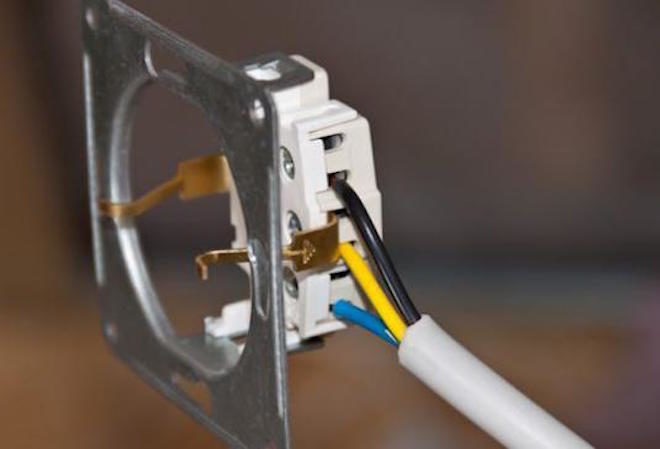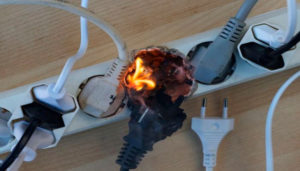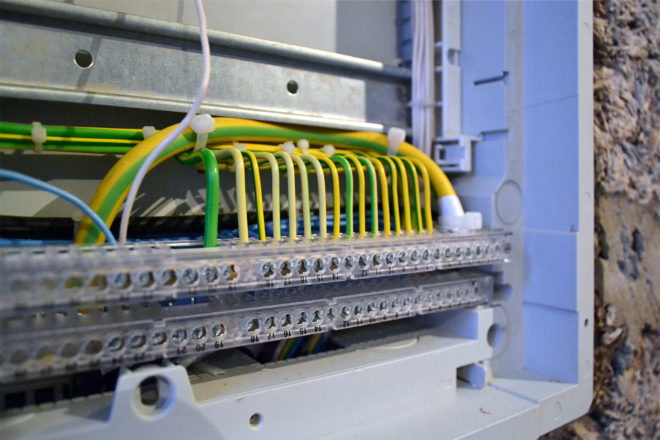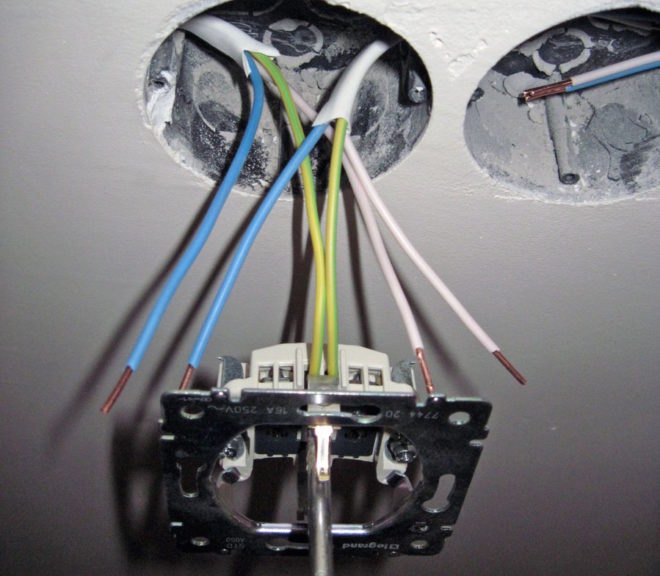Connecting a grounded outlet - right and wrong methods

PUE unambiguously speak of the need to use grounding - this allows you to get the maximum degree of protection against electric shock and simply improve the quality of operation of sensitive electrical equipment. There are several ways to connect a grounded outlet, and which one to use depends on the initial presence or absence of a grounding wire in the network.
Content
How grounding protects the outlet

The most unpleasant thing that can happen to the electrical wiring is a short circuit - contact between the neutral and phase conductors. At this moment, the current strength increases abruptly and if a person touches a part of the device that is not a dielectric, then the probability of receiving an electric shock of increased power is very high.
If there is a grounding in the outlet, this means that the outer parts of the appliance, capable of conducting electric current, are directly connected to the ground - in fact, a conductor of unlimited capacity. Since it is more convenient for an electric current to run along a ground wire (its resistance is an order of magnitude lower than that of human skin), in the event of a short circuit it will go exactly there. If, at the same time, the wiring is done correctly - there are circuit breakers and RCDs in the circuit, then when voltage hits the body of the electrical appliance, the electricity will turn off after about 0.3-0.5 seconds. Even if it is a short circuit, the wires will probably have time to burn, but the person will remain unharmed.
As a result, it would be more correct to say that a grounded outlet protects not so much itself as the person who uses it. At the same time, this protection in most cases is needed for a fraction of a second, which is necessary for automation to disconnect the damaged section of the wiring from the network.
If the wiring already has a ground wire
This may well be if a modern renovation was made in an old building. Initially, there was no grounding in the corridor shield, and the electricians installing the wiring could install euro sockets and lay grounding wires, but not connect them. If, in accordance with the plan for improving the electrical wiring, grounding was brought to the driveway panel, then the internal wiring made "for growth" becomes relevant.

In this case, the installation task is as simple as possible and consists only in the correct connection of all wires. The ground wire in the access panel is connected to the PE bus and in the apartment sockets it is connected to the corresponding contacts. To do this, follow these steps:
- Disconnect the input circuit breaker or de-energize the outlet itself, if there is a separate switch for this.
- Take a socket with grounding contacts. If those already exist on the old one, then they just need to be connected.
- Remove the cover from the old socket, loosen the fasteners holding the inner part in the socket and pull it out.
- If the old socket has a grounding contact, then screw it to the corresponding mount. If you need to put a new one, then the wires are removed from the old one and the necessary socket is put in its place.
- After connecting the wires and turning on the input machine, it is necessary to check whether the grounding is working correctly.
When the grounding wiring is connected correctly, then when checking it, the RCD circuit breaker will operate if it is installed on the phase and neutral wires.
How to ground a double socket
The procedure for connecting a double socket is exactly the same as for a regular socket if it is a single socket model. In it, one grounding contact is made for both sockets, so the part of it that is inserted into the socket is no different from a standard device.

It's another matter if the double socket is drawn from two ordinary ones located next to each other. In this case, the grounding must be considered as made for two separate points and the installation of the grounding wire is performed somewhat differently than phases and zero. The difference is that often a plug-in socket strip is connected to each other by a loop when wires go to the next point from the contacts of the previous one.
If a wire burns out in any place, then the next sockets in the chain will not work. This is not a potential risk of electric shock, unlike the failure of the ground wire. To avoid this, before connecting a double socket, recruited from ordinary, the ground wire is laid in one piece to the last connection point, and twists are made opposite the previous ones, from which the grounding already goes to the grounding contacts.
If there is no ground wire in the outlet
It all depends on where exactly you need to connect the socket with grounding - in a private house or an apartment building. In the second case, you still need to find out if there is a grounding bus in the floor panel - the situation may well be the opposite of the previous one - when the wiring in the apartment is old, and the floor panel has already been redone to new standards and there is a bus in it for connecting a PE conductor.
If there is no grounding bus in the floor panel, then the grounding of the sockets will not work on your own. More precisely, it can be done, but it will be a violation - interference with the approved scheme of the house, etc. As a result, if there is no grounding, then all residents of the house need to get together and write a collective statement so that the ZhEK employees carry out all the necessary work. There are no other options to do everything legally.
Also, the choice of the connection method depends on whether you need to ground one outlet or to ground all that are in the apartment. If you can connect grounding with external wiring to one outlet, then if you need to rework all points in the apartment, you will have to carry out large-scale work to replace the electrical wiring, which are usually done only during major repairs. They consist in removing the old wiring from the wall, and in its place install a new one, in which, among other things, there will also be a ground wire. It is not worth considering the option when the grounding conductor will simply be added. The wiring is most likely old by itself, plus, there is usually no exact wiring diagram for the cables inside the wall, so making new grooves for grounding without damaging the old wires is quite problematic.
When you can't, but really want to
There are many ways how to install a grounded outlet bypassing the provisions of the PUE. All of them are, to a greater or lesser extent, a violation - to use them or not - this decision is made at your own peril and risk, but in any case, you need to be aware of the possible consequences. The fact is that many of these methods are used happily ever after, but sooner or later something happens that is why they were banned. As a result, disregard for electrical safety rules endangers the life or health of not only the owner of such wiring, but also other people living with him in the same house.
Zeroing
This is one of the most common ways to ground an outlet if a separate PEN conductor is missing. To make zeroing, it is necessary to connect the working zero to the grounding contact - this is done by installing a jumper in the outlet itself. The wiring diagram of this "protection" method is based on the fact that even in the old wiring, the working neutral conductor is grounded in the distribution transformer. After short-circuiting the zero and grounding, in the event of a phase appearing on the device case, a short circuit will occur and the input circuit breaker will turn off the electricity.
Cons of grounding:
- When the phase "breaks through" to the case, the device, although not for long, is still energized and if at this moment a person touches it, he will receive an electric shock.
- If the neutral wire burns out on the way to the outlet in the wiring (a fairly frequent wiring malfunction), then in most cases there will be a phase on the instrument case. For this, a single not turned off light bulb or power supply unit of any device is enough. In this case, the circuit breaker does not work.
Learn more about the dangers of ground zeroing in this video:
Lightning rod connection
If a lightning rod is installed on the roof of the house, and the metal strip that connects it to the ground runs close to the apartment window, then you can connect to the ground loop and ground all the sockets.
An excellent way to solve the problem, as a result of which the apartment will be connected to a high-quality ground. This method has only one drawback - grounding works well until the lightning rod is used for its intended purpose, or rather, until lightning strikes it. What voltage will arise in this case on the cases of devices connected to the ground, it is better not to know and not to experience on our own experience.
Grounding through heating pipes or plumbing
Another common way to make your own grounding to an outlet is to strip a piece of water pipe and connect a ground wire to it. On the one hand, it would seem a logical solution - pipes in any case have contact with the ground. On the other hand, it is not known how this contact meets the requirements for grounding and if voltage appears on them, then there is a possibility that the current will not go into the ground, but will hit the person who is holding on to the pipe (washing or drawing water from the tap).
An additional disadvantage of such a solution is plastic water supply, which is often laid instead of rusted iron pipes. If on the fifth floor the pipes are metal, and on the third they are already plastic, then instead of grounding the pipes will simply be energized.
Grounding in a private house

To fully imagine how to connect a grounded outlet, you need to consider the whole process from start to finish, using the example of a private house, if the ground wire was not there initially:
- Installation of the ground loop. It represents metal pins driven into the ground, at the top points connected by metal strips welded to them. The length of the pins is 1.5-2 meters, and the metal strips, depending on the type of contour: triangle, tape, square or round. To install the circuit, you need to dig a trench 0.5 meters deep.
- "Ground" lead to the switchboard. It is carried out with the same metal strip as for connecting the pins.
- Replacing a two-wire wiring with a three-wire one. If it was not there before, then it is imperative to install an RCD, which guarantees a power outage when a voltage appears on the grounding conductor.
- Installation of sockets.
Which grounding method to choose
It is possible to correctly connect the grounding to the sockets in the apartment or house only if there is a grounding bus in the distribution board.If it is not there, then nothing can be done on your own - you need to achieve connection in the appropriate authorities. All work must be carried out by the services that serve the house, and their result is recorded in the wiring diagram of the electrical network.
In the private sector, you can make a separate grounding loop, but it is better to solve this issue even during the construction of a house, since in addition to installing the grounding bus itself, you will have to additionally redo the already finished wiring.




